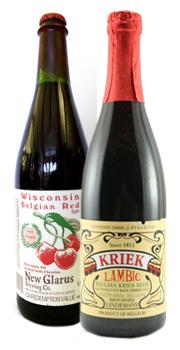Last Friday night, amid a tour of the world of fruit beer, I larked into a gas station convenience store. Beyond the dewy doors of its refrigerated merchandisers, I spotted Great South Bay’s Blood Orange Pale Ale (with its nice bitter nose), and a little way over I glimpsed Coney Island Brewing’s Tunnel of Love Watermelon Wheat (with its wet scent of cotton candy). There was Abita Strawberry Harvest Lager, which tastes as if it is digesting a Starburst, and there was Samuel Adams Cherry Wheat, which is what I’m drinking right now. (It arrived on the palate, from Boston, as boisterous as soda pop, briefly whipped up a nostalgia for cough syrup, and courteously faded away with a gentle Rolling Rock–level finish.) This iridescent shimmer is a seasonal feature of beer culture: Shopping for a six-pack at any fine filling station, you browse an oil-puddle array of flavors.
Fruit beers gain their personalities from the addition of whole fruits, fruit juices, fruit extracts, or molecules contemptuously engineered by corporate flavor chemists. They prove rather tempting at this time of year, and why not? Beer slakes a summer’s thirst, and fruit has proved seductive since the long-ago day when a young lady tasted the fruit of the tree in the midst of her garden so that she might be as God, knowing good and evil. Put the two together and there you are, lazing about in a fig leaf, sipping a Dogfish Head Aprihop in a spirit of vacation-time adventure or a Bar Harbor True Blue Blueberry Ale in a quest for Vacationland novelty. Alternatively, there you are, knowing the iniquity of Anheuser-Busch’s Wild Blue, a cynical lager described by one of Beer Advocate’s founders as smelling “of canned blueberry pie filling and a clean solvent alcohol.”
Despite the knowledge we mortals have achieved in the post-lapsarian era, the full history of fruit beer remains obscure. Did it originate in ancient Egypt? Stone Age China? No one really cares. Instead, interested parties spend their time agreeing that fruit and beer have been most complexly mated in Belgium, where subsets of lambic beers—products of spontaneous fermentation, relying on wild yeasts, crazy with mouth-puckering funk—take on the fleshy freshness of cherries or raspberries or blackcurrants, most traditionally.
With some effort, you can acquire some Cantillon Kriek Lambic, a sour-cherry superstar, but it might prove difficult yet to acquire a taste for it; this brewery is favored by people who intend a compliment when describing a “barnyard-y band-aid-y smell.” With a trip to Milwaukee, you will be in one of the few places in the world where you can buy the highly regarded lambic-ish beers made by the New Glarus Brewing Company; please pick me up a quarter barrel of Wisconsin Belgian Red. With a quick lowering of your standards, you can save yourself some trouble and go to your local beverage-supply store, or maybe just the supermarket, for Lindemans Kriek, made with cherry juice; it is sweet enough to please a crowd but not cloying. Only a true snob would harrumph to see it served, in a champagne flute, with dessert.

Product shot
The men and women of the RateBeer community name-checked both Belgian Red and Lindemans when taking nominations for “The Ultimate Chick Beer.” Other contenders for that controversial designation included Wittekerke Rosé, Pete’s Wicked Strawberry Blonde, Leinenkugel Berry Weiss—and also, duh, a non-fruit beer frequently accessorized with an orange wheel: Blue Moon. (To review, chick is a common archaism meaning young woman. Here, have a recent usage example: “Fruit beers are popping up everywhere, and most guys [sic] immediate response is that they’re chicks [sic] beers. I don’t want to go all Jezebel on you, but that’s the dumbest thing I’ve ever heard.”) Yes, a fruit beer, properly poured, develops a head frothing with aromatic gender discourse. Draft Magazine begins its helpful online guide to the genre by stating the matter plainly: “Fruit beers have a bad rap as feminine beer impostors, though the style is actually heavily nuanced.”
Treating this matter with the seriousness it deserves, I’d like briefly to address any socially insecure bros who happen to be grazing these pixels: You need to know that, if you publicly drink a fruit beer—if you are drawn to the not-bad taffyish tug of Wells Banana Bread Beer or to the raspberry creamy-crispness and after-dinner dulcitude of Founders Rübæus—there’s a 20 to 30 percent chance that your fellow bros will tease you about it, possibly by way of strained ovary jokes.
Don’t stand for it. Point out that some of the most popular fruit beers have much in common with traditional macrobrew machoswill: A fuzzy apricot slug of Magic Hat No. 9 will well wash down a mouthful of spicy barbecue, for instance, and Hell or High Watermelon Wheat Beer, from 21st Amendment, is familiar in its gluggable blandness; its tropical bouquet is like a candied cloud of perfume hovering at a taproom ceiling.
Shall we weigh Draft’s implicit sneer against the un-nuanced tastes of womankind against the research that led Heineken to pinkly pitch women a rosé beer that tastes “like some fruity Fanta”? Must we? While awaiting a good argument in favor of opening that can of worms, I will crack open a can of Abita Purple Haze, which is light-bodied and raspberry-bereted. Though by no means a great beer, Purple Haze is carefree and cheerful. It’s easy, as the living is meant to be, and thus pairs beautifully with mowing the lawn or otherwise cultivating one’s own garden.
